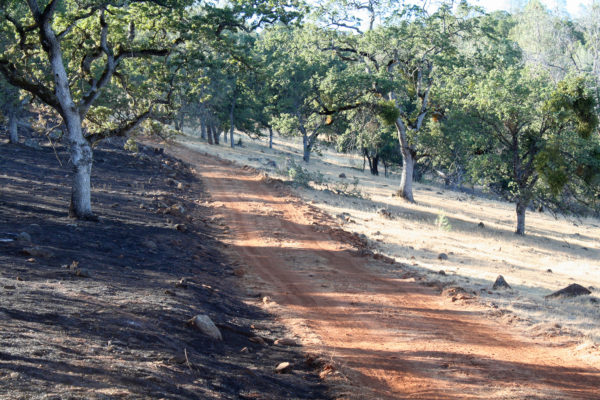Living with Wildfire
Contributed by Dan Macon
As our annual grasses turn from springtime green to summertime brown, I find myself looking skyward. Not for divine intervention in the form of rain (although I do that sometimes, too), but rather at the aircraft that are frequently overhead here in the foothills. Winter airplanes may be fun to watch, but summer airplanes – especially those with twin engines and large black numbers on their tails – are worrisome.
I always watch for CalFire planes during the summer and autumn months – the closest fire base is in Grass Valley. Low flying planes are especially troubling – the lower the altitude, the closer the fire. When I see planes circling, I start looking for a column of smoke to help me narrow down the location of the fire. Those of us who graze livestock in our fire-prone foothills have a pretty good sense of who might be threatened when we see smoke or planes flying – and we call each other to make sure everything (and everybody) is safe.
For our own operation, I take several precautions. First, I carry a 5-gallon backpack pump and a McLeod (a fire hoe) with me at all times during the fire season – I’ve never had to use them, but I feel better know ing I’m well-equipped. Second, I try to prepare a plan for evacuating my sheep if a fire should occur nearby. My greatest fear is that we’d have a fire that moves more quickly than we could evacuate – our current flock of ewes takes two trailer loads to move. Since there is always a possibility that we couldn’t load and move this many sheep quickly enough, my evacuation plans generally include the identification of a safe zone where we could herd the sheep out of harms way. Finally, we watch the weather (as we do all year long). High temperatures, low humidity and windy conditions make me especially vigilant, as does the Independence Day holiday. One idiot with a firecracker can mean disaster in the foothills.
There are also things I don’t do during fire season. I don’t use my lawnmower in dry grass after about 9 a.m. (and not at all if the humidity is low and/or the wind is blowing), nor do I run my chainsaw. Even though I drive a diesel truck (without a catalytic converter, a diesel’s exhaust system doesn’t produce as much heat as a gasoline engine), I don’t drive over dry vegetation, either. Some of my ranching friends who raise cattle in areas where the rocks are flint (instead of the granite we have in our area) put copper shoes on their horses in the summertime. A steel shoe on flint can create enough spark to start a grassfire.
Finally, I stay tuned in to local information sources. While we have several local radio stations that do a pretty good job of reporting local fires, I’ve found that www.yubanet.com is the most accurate and fastest source of fire information. Now that I carry a smart phone, I can access YubaNet anywhere I have cell service, which is great.
Several weeks ago, the sound of fire planes alerted me to a column of smoke to the north of our home place. While the fire didn’t threaten us, it looked close to ranches that my friends Joe Fischer and Loren Oest manage between Auburn and Grass Valley. A few quick text messages confirmed that they (and their cattle) were safe. Thankfully, CalFire jumped on it quickly and held it to a couple of acres. I having a feeling, though, that it will be a long and dangerous summer. Indeed, CalFire reports that our ongoing drought has resulted in June fire conditions that are more like September – the vegetation is bone dry and there’s not much water for fighting fires. As the Fourth of July approaches, please be careful!
Graphic courtesy National Weather Service.

